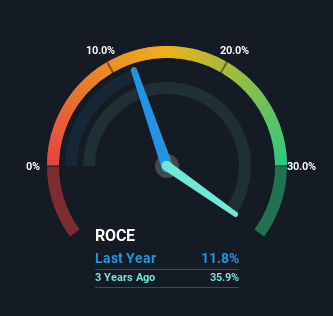- Hong Kong
- /
- Consumer Durables
- /
- SEHK:1925
Kwung's Holdings (HKG:1925) Will Want To Turn Around Its Return Trends

If we want to find a potential multi-bagger, often there are underlying trends that can provide clues. Amongst other things, we'll want to see two things; firstly, a growing return on capital employed (ROCE) and secondly, an expansion in the company's amount of capital employed. If you see this, it typically means it's a company with a great business model and plenty of profitable reinvestment opportunities. However, after investigating Kwung's Holdings (HKG:1925), we don't think it's current trends fit the mold of a multi-bagger.
What Is Return On Capital Employed (ROCE)?
If you haven't worked with ROCE before, it measures the 'return' (pre-tax profit) a company generates from capital employed in its business. To calculate this metric for Kwung's Holdings, this is the formula:
Return on Capital Employed = Earnings Before Interest and Tax (EBIT) ÷ (Total Assets - Current Liabilities)
0.12 = CN¥51m ÷ (CN¥662m - CN¥235m) (Based on the trailing twelve months to December 2022).
Therefore, Kwung's Holdings has an ROCE of 12%. On its own, that's a standard return, however it's much better than the 8.3% generated by the Consumer Durables industry.
See our latest analysis for Kwung's Holdings

While the past is not representative of the future, it can be helpful to know how a company has performed historically, which is why we have this chart above. If you want to delve into the historical earnings, revenue and cash flow of Kwung's Holdings, check out these free graphs here.
So How Is Kwung's Holdings' ROCE Trending?
When we looked at the ROCE trend at Kwung's Holdings, we didn't gain much confidence. Over the last five years, returns on capital have decreased to 12% from 25% five years ago. Although, given both revenue and the amount of assets employed in the business have increased, it could suggest the company is investing in growth, and the extra capital has led to a short-term reduction in ROCE. If these investments prove successful, this can bode very well for long term stock performance.
While on the subject, we noticed that the ratio of current liabilities to total assets has risen to 35%, which has impacted the ROCE. Without this increase, it's likely that ROCE would be even lower than 12%. Keep an eye on this ratio, because the business could encounter some new risks if this metric gets too high.
The Bottom Line On Kwung's Holdings' ROCE
Even though returns on capital have fallen in the short term, we find it promising that revenue and capital employed have both increased for Kwung's Holdings. And long term investors must be optimistic going forward because the stock has returned a huge 140% to shareholders in the last three years. So while investors seem to be recognizing these promising trends, we would look further into this stock to make sure the other metrics justify the positive view.
One more thing, we've spotted 2 warning signs facing Kwung's Holdings that you might find interesting.
If you want to search for solid companies with great earnings, check out this free list of companies with good balance sheets and impressive returns on equity.
Valuation is complex, but we're here to simplify it.
Discover if Kwung's Aroma Holdings might be undervalued or overvalued with our detailed analysis, featuring fair value estimates, potential risks, dividends, insider trades, and its financial condition.
Access Free AnalysisHave feedback on this article? Concerned about the content? Get in touch with us directly. Alternatively, email editorial-team (at) simplywallst.com.
This article by Simply Wall St is general in nature. We provide commentary based on historical data and analyst forecasts only using an unbiased methodology and our articles are not intended to be financial advice. It does not constitute a recommendation to buy or sell any stock, and does not take account of your objectives, or your financial situation. We aim to bring you long-term focused analysis driven by fundamental data. Note that our analysis may not factor in the latest price-sensitive company announcements or qualitative material. Simply Wall St has no position in any stocks mentioned.
About SEHK:1925
Kwung's Aroma Holdings
An investment holding company, engages in the design and manufacturing of home fragrance related products in the People’s Republic of China and internationally.
Solid track record with adequate balance sheet.
Market Insights
Community Narratives




